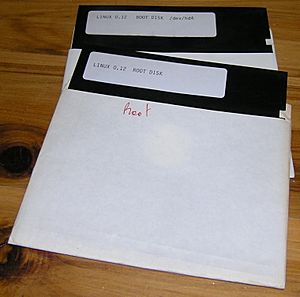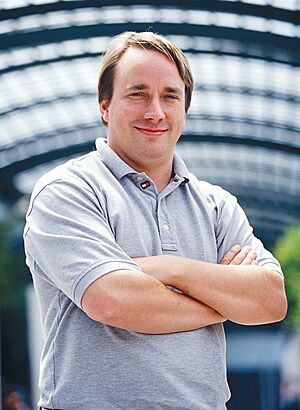History of Linux facts for kids
Linux started in 1991 as a personal project by Linus Torvalds, a student from Finland. He wanted to create a new, free operating system kernel. A kernel is the main part of an operating system that controls the computer's hardware and software. Since its first release, the Linux kernel has grown a lot. In 1991, it was just a few computer files. By 2018, version 4.15 had over 23.3 million lines of code! It's released under the GNU General Public License (GPL), which means it's free for everyone to use and change.
Contents
- How Linux Was Born
- Linus Torvalds Creates Linux
- How Linux Got Its Name
- Linux and the GNU GPL License
- The "GNU/Linux" Name Debate
- Linux's Official Mascot
- How Linux Continues to Grow
- "Linux is Obsolete" Debate
- Microsoft and Linux: From Rivals to Collaborators
- SCO Lawsuits
- Trademark Rights for "Linux"
- Timeline of Linux
- See also
How Linux Was Born
The story of Linux begins with another operating system called Unix. It was created in 1969 by Ken Thompson and Dennis Ritchie at AT&T. They later rewrote Unix using a new programming language called C. This made Unix easy to move to different computers, so many schools and businesses started using it.
In 1977, a version of Unix called Berkeley Software Distribution (BSD) was made at UC Berkeley. But AT&T, who owned the original Unix code, sued UC Berkeley in the early 1990s. This made it hard for BSD to grow.
Around the same time, in 1983, Richard Stallman started the GNU Project. His goal was to create a free operating system that worked like Unix. He also created the GNU General Public License (GPL), which lets people use and share software freely. By the early 1990s, GNU had almost all the parts for a full operating system, except for the main kernel. Their kernel, called Hurd, wasn't ready yet.
In 1985, Intel released the 80386 processor. This was a powerful new computer chip for personal computers. It made it possible to create more advanced operating systems.
Also, in 1987, a Unix-like system called MINIX was released by Andrew S. Tanenbaum. It was made for teaching, but it had some limits. It was designed for older 16-bit chips, not the newer 32-bit Intel 386 chips. Also, commercial Unix systems for these new PCs were very expensive for regular people.
Because there wasn't a good, free kernel available, Linus Torvalds decided to start his own project. He said that if the GNU Hurd or 386BSD kernels had been ready, he probably wouldn't have written Linux.
Linus Torvalds Creates Linux
In 1991, while studying at the University of Helsinki, Linus Torvalds began working on what would become the Linux kernel. He wrote it specifically for his new computer, which had an 80386 processor. He used MINIX and the GNU C Compiler to develop it.
On August 25, 1991, Linus (who was 21 years old) announced his project in an online message. He said he was making a "free operating system (just a hobby, won't be big and professional like gnu)." He asked for feedback from people using MINIX.
Linus wrote:
Hello everybody out there using minix -
I'm doing a (free) operating system (just a hobby, won't be big and professional like gnu) for 386(486) AT clones. This has been brewing since april, and is starting to get ready. I'd like any feedback on things people like/dislike in minix, as my OS resembles it somewhat (same physical layout of the file-system (due to practical reasons) among other things).
I've currently ported bash(1.08) and gcc(1.40), and things seem to work. This implies that I'll get something practical within a few months, and I'd like to know what features most people would want. Any suggestions are welcome, but I won't promise I'll implement them :-)
Linus (torvalds@kruuna.helsinki.fi)
PS. Yes - it's free of any minix code, and it has a multi-threaded fs. It is NOT portable (uses 386 task switching etc), and it probably never will support anything other than AT-harddisks, as that's all I have :-(.
Linux became more important in 1992 when the X Window System was added. This allowed Linux to have a GUI (Graphical User Interface) for the first time, meaning you could use a mouse and see windows on the screen.
How Linux Got Its Name

Linus Torvalds first wanted to call his project "Freax." This name was a mix of "free," "freak," and "x" (like Unix). He used this name for about six months. He had thought about "Linux" but thought it sounded too much like his own name.
In September 1991, the files were uploaded to a server at FUNET to help with development. Ari Lemmke, who managed the server, didn't like the name "Freax." So, he named the project "Linux" on the server without asking Linus. Linus later agreed to the name.
To show how to say "Linux," Linus even included an audio guide with the kernel's source code.
Linux and the GNU GPL License
Linus first released the Linux kernel under his own license, which didn't allow commercial use.
However, the software needed to use the kernel, like the shell and compilers, came from the GNU project. This GNU software was licensed under the GNU General Public License (GPL), which is a free software license. Linus's first release of Linux (version 0.01) even included a part of GNU's Bash shell.
In 1992, Linus decided to release the Linux kernel itself under the GNU GPL. He announced this with version 0.12 and fully switched to GPL with version 0.99 in December 1992. This meant Linux and GNU developers could work together to create a complete, free operating system. Linus said that making Linux GPL was "definitely the best thing I ever did."
Around 2000, Linus clarified that the Linux kernel uses GPL version 2, without the option to use "any later version." When GPL version 3 was released in 2007, Linus and most kernel developers chose not to adopt it.
The "GNU/Linux" Name Debate
The name "Linux" was originally just for the kernel. But the kernel was often used with other software, especially from the GNU project. This combination quickly became very popular. In 1994, the GNU project started calling this combination a "free UNIX clone." The Debian project also began calling its product "Debian GNU/Linux."
In 1996, Richard Stallman suggested calling the whole system "GNU/Linux" to give credit to the GNU project for all the other software parts. While the GNU and Debian projects use this name, most people simply say "Linux" to refer to the entire operating system.
Linux's Official Mascot
In 1996, Linus Torvalds announced that Linux would have a mascot: a penguin! He chose a penguin because he had been bitten by a small penguin during a visit to a zoo in Australia.
Larry Ewing drew the first picture of the famous penguin mascot based on Linus's description. The name Tux was suggested by James Hughes. It's a mix of "Torvalds' UniX" and also sounds like "tuxedo," which is a suit that looks like a penguin's colors.
How Linux Continues to Grow
The Linux Community
Most of the work on Linux is done by a huge community. Thousands of programmers worldwide use Linux and send their ideas and improvements to the people who manage the kernel. Many companies also help develop the kernel and create other software that comes with Linux. By 2015, over 80% of Linux kernel developers were paid for their work.
Linux is released by groups like Debian and by companies like Fedora and openSUSE. People from these projects meet at conferences to share ideas. One big event is LinuxTag in Germany, where about 10,000 people gather each year.
Open Source Development Lab and Linux Foundation
The Open Source Development Labs (OSDL) started in 2000. It was a non-profit group that aimed to make Linux better for big computer systems. Linus Torvalds worked full-time for OSDL, focusing on developing the Linux kernel.
In 2007, OSDL joined with another group to form The Linux Foundation. This new organization works to promote Linux and help it compete with systems like Microsoft Windows. Linus Torvalds still works there as a Fellow.
Companies and Linux
Even though Linux is free, many companies make money from it. These companies, often members of the Linux Foundation, put a lot of effort into improving Linux. They want to make it useful for different purposes. This includes giving hardware to developers, donating money, and hiring Linux programmers.
For example, companies like Dell, IBM, and Hewlett-Packard use and sell Linux on their own servers. Red Hat and SUSE create their own versions of Linux for businesses. Digia also helps Linux by developing the Qt toolkit, which is used to create desktop environments like KDE.
Desktop Environments
A desktop environment is what you see and interact with on your computer screen, like the menus, icons, and windows. KDE was one of the first advanced desktop environments for Linux, released in 1998. It used a toolkit called Qt.
Because of some licensing questions about Qt, GNOME was developed as an alternative. KDE and GNOME use different tools and are supported by different groups.
Later, some users were unhappy with changes in GNOME 3 (released in 2011). This led to new desktop environments like Cinnamon, which was created by the Linux Mint team. Cinnamon brought back a more traditional look.
Ubuntu, another popular Linux version, created its own interface called Unity in 2011. Unity was very different from other desktops. Ubuntu later stopped using Unity and went back to GNOME for its releases from 2017 onwards.
"Linux is Obsolete" Debate
In 1992, Andrew S. Tanenbaum, the creator of MINIX, wrote an online message titled "Linux is obsolete." This started a famous debate about the design of the Linux kernel. His main criticisms were:
- Linux's kernel was "monolithic," meaning it was one big piece of code, which he thought was old-fashioned.
- Linux was too tied to the Intel 386 processor and not easily moved to other computer types.
- He thought there wasn't enough control over the source code.
Tanenbaum predicted that Linux would become outdated and be replaced by GNU Hurd, which he thought was more modern. However, he was wrong. Linux has been moved to almost all major computer types, and its open way of developing has made it grow very fast. GNU Hurd, on the other hand, has not yet become stable enough for common use.
Kenneth Brown later claimed that Linus Torvalds illegally copied code from MINIX. But in 2004, Tanenbaum himself denied these claims. He said that while MINIX influenced Linux, he didn't believe Linus used any of his actual code. Brown's claims were questioned, and his book was never released.
Microsoft and Linux: From Rivals to Collaborators
For a long time, Microsoft saw Linux as a threat. Between 1997 and 2001, there were many disagreements. In 1998, a document called the "Halloween document" was leaked from Microsoft. It talked about the threats from free software like Linux and how to fight them. Microsoft also published comparisons claiming Windows was better than Linux.
In 2004, Microsoft launched a campaign called "Get the Facts," claiming that using Linux for businesses was worse than Windows in terms of reliability, security, and cost. Linux companies like Novell and IBM responded with their own studies and stories to show Linux's advantages.
However, things started to change. In 2006, Novell and Microsoft announced an agreement to work together on software. In 2009, Microsoft even contributed 22,000 lines of code to the Linux kernel under the GPLV2 license. This was a big step, though it was also done to avoid legal problems for Microsoft. In the past, Microsoft had called Linux a "cancer" and "communist."
By 2011, Microsoft was one of the top contributors to the Linux kernel. More recently, Microsoft has embraced open-source software. Their Microsoft Azure cloud computing service uses Linux. Linus Torvalds has said that Microsoft is now much friendlier and that the "anti-Microsoft thing was sometimes funny as a joke, but not really." In 2023, Microsoft even released its own Linux version called Azure Linux.
SCO Lawsuits
In 2003, a company called SCO Group accused IBM of illegally copying code from UNIX (which SCO claimed to own) into Linux. SCO sued IBM and also tried to sell "Linux licenses" to users. However, Novell also claimed to own the UNIX copyrights and sued SCO.
In 2007, a court ruled that SCO did not actually own the UNIX copyrights. Although there were more legal steps, the jury eventually decided in Novell's favor in 2010. SCO later filed for bankruptcy.
Trademark Rights for "Linux"
In the mid-1990s, some people tried to register the name "Linux" as a trademark in different countries. They then asked Linux companies for money to use the name. Many developers and users were unhappy about this.
Linus Torvalds stepped in and was granted the trademark for "Linux." He then gave the trademark to Linux International to manage. Later, a non-profit group called the Linux Mark Institute took over protecting the trademark.
In 2000, Linus set up rules for using the "Linux" name. If a company offers a product or service with the name "Linux," they usually need a license for it.
In 2005, there was a new debate when the Linux Mark Institute increased the price for using the name. This upset the community. Linus Torvalds explained that the fees were needed to cover the rising costs of protecting the trademark legally. He also clarified that he doesn't get any money from these fees, and the Linux Mark Institute often lost money on it because lawyer fees were so high.
Since then, the Linux Mark Institute has started offering a free, worldwide license for using the "Linux" name.
Timeline of Linux
- 1991: Linus Torvalds, a 21-year-old student, publicly announces the Linux kernel on August 25. Version 0.01 is released on September 17.
- 1992: The Linux kernel changes its license to the GNU GPL. The first Linux distributions (complete versions of Linux) are created.
- 1993: Over 100 developers work on the Linux kernel. The oldest existing Linux distribution, Slackware, is released. The Debian project also starts.
- 1994: Linus Torvalds releases version 1.0 of Linux. The XFree86 project adds a graphical user interface (GUI). Companies like Red Hat and SUSE release their first Linux versions.
- 1995: Linux is made to work on other computer types, like DEC Alpha and Sun SPARC.
- 1996: Version 2.0 of the Linux kernel is released. It can now use multiple processors at once, making it useful for many companies.
- 1998: Big companies like IBM and Oracle announce support for Linux. The essay "The Cathedral and the Bazaar" is published, drawing attention to Linux's open-source development. The graphical interface KDE begins development. Linux appears on the TOP500 list of fastest supercomputers for the first time.
- 1999: Developers start working on GNOME, another graphical environment. IBM announces a big project to support Linux. Version 2.2 of the Linux kernel is is released.
- 2000: Dell becomes a major seller of Linux-based systems.
- 2001: Version 2.4 of the Linux kernel is released.
- 2003: Version 2.6 of the Linux kernel is released.
- 2004: The X.Org Foundation is formed, leading to faster development of the X server for Linux.
- 2005: The openSUSE project starts. OpenOffice.org releases version 2.0, supporting OpenDocument standards.
- 2006: Oracle releases its own version of Linux. Novell and Microsoft announce they will work together.
- 2007: Dell starts selling laptops with Ubuntu already installed.
- 2009: Red Hat's value equals Sun's, showing the growth of the "Linux-based economy."
- 2011: Version 3.0 of the Linux kernel is released.
- 2012: Linux server sales earn more money than all other Unix servers combined.
- 2013: Google's Linux-based Android takes 75% of the smartphone market.
- 2014: Ubuntu reports 22,000,000 users.
- 2015: Version 4.0 of the Linux kernel is released.
- 2017: All of the TOP500 fastest supercomputers in the world run Linux.
- 2019: Version 5.0 of the Linux kernel is released.
- 2022: Version 6.0 of the Linux kernel is released.
See also
 In Spanish: Historia de Linux para niños
In Spanish: Historia de Linux para niños
- History of free and open-source software
- Linux kernel version history




